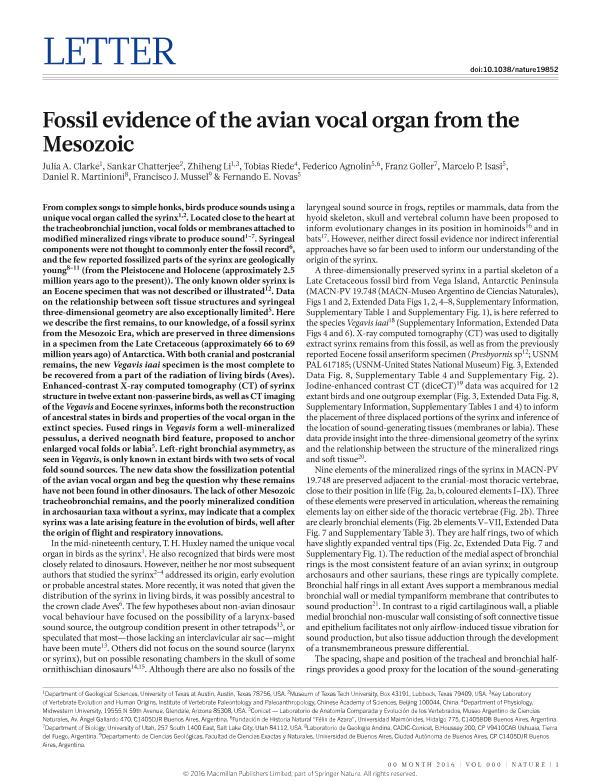Artículo
Fossil evidence of the avian vocal organ from the Mesozoic
Clarke, Julia A.; Chatterjee, Sankar; Li, Zhiheng; Riede, Tobias; Agnolin, Federico ; Goller, Franz; Isasi, Marcelo Pablo
; Goller, Franz; Isasi, Marcelo Pablo ; Martinioni, Daniel Roberto
; Martinioni, Daniel Roberto ; Mussel, Francisco J.; Novas, Fernando Emilio
; Mussel, Francisco J.; Novas, Fernando Emilio
 ; Goller, Franz; Isasi, Marcelo Pablo
; Goller, Franz; Isasi, Marcelo Pablo ; Martinioni, Daniel Roberto
; Martinioni, Daniel Roberto ; Mussel, Francisco J.; Novas, Fernando Emilio
; Mussel, Francisco J.; Novas, Fernando Emilio
Fecha de publicación:
10/2016
Editorial:
Nature Publishing Group
Revista:
Nature
ISSN:
0028-0836
Idioma:
Inglés
Tipo de recurso:
Artículo publicado
Clasificación temática:
Resumen
From complex songs to simple honks, birds produce sounds using a unique vocal organ called the syrinx. Located close to the heart at the tracheobronchial junction, vocal folds or membranes attached to modified mineralized rings vibrate to produce sound. Syringeal components were not thought to commonly enter the fossil record, and the few reported fossilized parts of the syrinx are geologically young (from the Pleistocene and Holocene (approximately 2.5 million years ago to the present)). The only known older syrinx is an Eocene specimen that was not described or illustrated. Data on the relationship between soft tissue structures and syringeal three-dimensional geometry are also exceptionally limited. Here we describe the first remains, to our knowledge, of a fossil syrinx from the Mesozoic Era, which are preserved in three dimensions in a specimen from the Late Cretaceous (approximately 66 to 69 million years ago) of Antarctica. With both cranial and postcranial remains, the new Vegavis iaai specimen is the most complete to be recovered from a part of the radiation of living birds (Aves). Enhanced-contrast X-ray computed tomography (CT) of syrinx structure in twelve extant non-passerine birds, as well as CT imaging of the Vegavis and Eocene syrinxes, informs both the reconstruction of ancestral states in birds and properties of the vocal organ in the extinct species. Fused rings in Vegavis form a well-mineralized pessulus, a derived neognath bird feature, proposed to anchor enlarged vocal folds or labia. Left-right bronchial asymmetry, as seen in Vegavis, is only known in extant birds with two sets of vocal fold sound sources. The new data show the fossilization potential of the avian vocal organ and beg the question why these remains have not been found in other dinosaurs. The lack of other Mesozoic tracheobronchial remains, and the poorly mineralized condition in archosaurian taxa without a syrinx, may indicate that a complex syrinx was a late arising feature in the evolution of birds, well after the origin of flight and respiratory innovations.
Palabras clave:
Vegavis Iaai
,
Vocal Organ
,
Antarctica
Archivos asociados
Licencia
Identificadores
Colecciones
Articulos(CADIC)
Articulos de CENTRO AUSTRAL DE INVESTIGACIONES CIENTIFICAS
Articulos de CENTRO AUSTRAL DE INVESTIGACIONES CIENTIFICAS
Articulos(MACNBR)
Articulos de MUSEO ARG.DE CS.NAT "BERNARDINO RIVADAVIA"
Articulos de MUSEO ARG.DE CS.NAT "BERNARDINO RIVADAVIA"
Citación
Clarke, Julia A.; Chatterjee, Sankar; Li, Zhiheng; Riede, Tobias; Agnolin, Federico; et al.; Fossil evidence of the avian vocal organ from the Mesozoic; Nature Publishing Group; Nature; 538; 7626; 10-2016; 502-505
Compartir
Altmétricas



